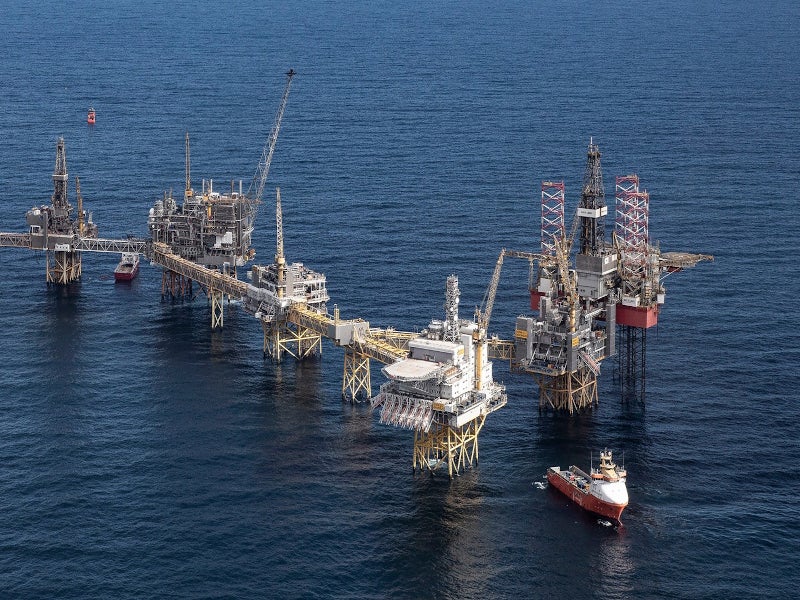Tommeliten Alpha is a gas and condensate field located at a water depth of 75m, approximately 25km south-west of the Ekofisk field in the southern part of the Norwegian North Sea.
ConocoPhillips Skandinavia operates the field with a 28.26% working interest. The other partners in the field are PGNiG Upstream Norway (42.38%), TotalEnergies EP Norge AS (20.23%), Var Energi (9.13%), ConocoPhillips (U.K.) Holdings (0.2109%), TotalEnergies UK (0.1510%) and Eni UK (0.0681%).
In June 2019, the project moved to the Select Phase, which involves making technical decisions related to the field development such as number and type of wells, and technical specification of subsea pipeline.
The plan for development and operation (PDO) of the field was submitted to the Norwegian Ministry of Petroleum and Energy and the UK Oil and Gas Authority in November 2021. The field is expected to start production in 2024.
Tommeliten Alpha field location
Tommeliten gas and condensate field, comprising Gamma and Alpha deposits, lies in Block 1/9 of the production licence (PL) 044 in the North Sea, Norway. The Tommeliten Alpha discovery is located in Block 1/9-1.
Tommeliten Alpha field geology and reserves
The oil and condensate in the field are found at a depth of approximately 3,000m in the chalk layers of the Paleocene Ekofisk and Upper Cretaceous Tor formations.
The Gamma deposit holds recoverable reserves of 24.5 million barrels of oil, 9.7 billion standard cubic metres (scm) of gas and 0.5 million tonnes (Mt) of natural gas liquids (NGL). Tommeliten Alpha is estimated to contain total recoverable reserves of approximately 12.8 billion cubic metres (bcm) of natural gas, 5Mt of oil and 0.5Mt of NGL.
Tommeliten Alpha field discovery and appraisal
The Tommeliten Alpha was discovered by the exploratory well 1/9-1 in 1977. Another wildcat well, 1/9-1 R, was spud in 1987 to prove the presence of gas and condensate in the field.
The appraisal wells, 1/9-2 and 1/9-3 R, encountered oil, and gas and condensate, respectively.
In 2003, ConocoPhillips drilled a wildcat well, 1/9-7, to evaluate the hydrocarbons potential in the Upper Jurassic age sandstone as well as to delimit the Tommeliten Alpha discovery in Cretaceous rocks. The well was drilled to a vertical depth of 4,947m below the seafloor, using the Maersk Giant jack-up rig.
Hydrocarbons were identified in Cretaceous rocks but not in the Upper Jurassic age sandstones. All the wells were plugged and abandoned.
Tommeliten Alpha field development details
Tommeliten Alpha will be developed with a subsea production system comprising wellheads, ten vertical subsea trees, two manifolds, satellite structures, as well as control and tie-in equipment.
The field will be tied back to the existing infrastructure of the Ekofisk complex for cost-efficient development of the project.
Details of Ekofisk complex
Ekofisk area lies in Block 2/4 of PL018, at a water depth of 70m to 75m in the southern part of the Norwegian North Sea. The area includes Ekofisk field, Embla, Tor, Cod, Mime, Edda, West Ekofisk, Albuskjell and Tommeliten Gamma fields.
Discovered in 1969, the Ekofisk field was developed in two phases – Ekofisk I, which was shut down in 1998, and Ekofisk II. The Ekofisk complex contains a centrally located installation linked to other platforms by bridges.
Tommeliten Gamma details
Tommeliten Gamma was approved for development in January 1986, while it came on stream in October 1988. Production from the Gamma field ceased in August 1998.
The field was developed with a subsea production system for producing hydrocarbons from six wells located at a water depth of 83m. The produced gas and condensate from the field was transported through a nine-inch pipeline to the Edda 2/7 C platform located 11.8km away for processing.
Contractors involved
REINERTSEN New Energy, an engineering company, won the contract to perform front-end engineering and design (FEED) for the subsea umbilicals, risers and flowlines system (SURF), subsea production system and topside engineering in 2018.
Aker Solutions performed the FEED for the project under a contract received in October 2020. The contractual scope included modifications on the Ekofisk installations for the integration of the Tommeliten Alpha discovery. The contract also includes an option for engineering, procurement and construction, and installation (EPCI) work.
The company received another contract worth Nkr1.2bn ($127.5m) in the same month to provide a subsea production system for the development.
Aker received a topside modification contract for the project in September 2021. The scope of work includes topside modifications on some of the Ekofisk installations, tie-back and integration of the Tommeliten Alpha field to the existing infrastructure. The work is expected to be completed by the third quarter of 2023. The contract has increased the total value of works awarded to Aker for the field development to more than Nkr2.7bn ($310.6m).
Prosafe was contracted by ConocoPhillips in October 2020 to provide accommodation support for the tie-in of the field. The company will provide either the Safe Boreas or Safe Zephyrus semi-submersible accommodation units under the contract, which is expected to commence in the second quarter of 2022.




